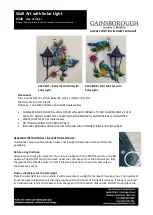
Operation
capaNCDT 6500
Page 29
5.4
Linearity Adjustment and Calibration with Insulator Targets
Preconditions:
-
Specific resistance of the target > 10
6
Ωcm.
-
Slide switch on the demodulator in position
Insul
. (Insulation, see
Fig. 27
)
The measuring channel must be individually linearized and calibrated prior to measure-
ments against insulator targets. Adjustment takes place at defined distances which are
prescribed by a reference. A special micrometer calibration device with a non-rotating
micrometer spindle (for example MC25 from MICRO-EPSILON) has proved to be particu-
larly suitable. Spacer discs are not suitable.
The following parameters influence the calibration. Later operating conditions should be
simulated as accurately as possible for the calibration. If one of these parameter chang-
es, recalibration is recommended.:
-
Resistivity of the target
-
Dielectric constant of the target
-
Shape and thickness of the insulator
-
With thin targets, metal behind the target may influence the propagation of the field
lines.
The bigger the relative dielectric constant of a measuring target is, the higher is the sen-
sitivity of the measuring system.
Step 1:
Settings:
-
Potentiometer “Zero“ (Zero-point)
right stop
-
Potentiometer “Gain“ (Amplification)
middle
-
Potentiometer “Linearity“ (Linearity)
middle
A
B
C
B-A
C-B
C-A
Signal
Displacement
Fig. 28 Define the active measuring range
Record the measuring curve of the sensor (at least 10 points). Choose a range of
low and as constant as possible curvature from this curve and determine the points:
-
A Start of measuring range
-
B Centre of measuring range
-
C End of measuring range
The output signal should not exceed 10 V in the chosen measuring range. If necessary,
the sensitivity can be reduced with the “Gain“ potentiometer.
Содержание capaNCDT 6500
Страница 67: ......
















































